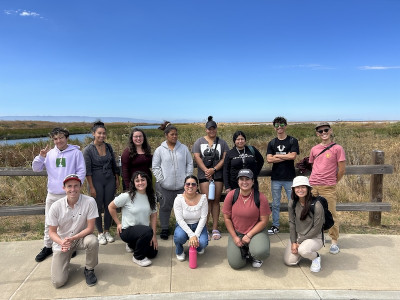The San Francisco Estuary stretches from the ridges of the Sierra Nevada mountains to the Golden Gate strait, where it meets the Pacific Ocean, an area bigger than the state of Georgia. At almost 60,000 square miles, it is one of the largest estuaries on the American continent. About eight million people live on or near the estuary’s shorelines. Hundreds of industries and thousands of wildlife species depend on the estuary, whose wetlands extend into several bays where freshwater and seawater mingle.
This confluence of nature on one side and human needs on the other made the estuary an ideal focal point for Will Geiken’s California Sea Grant State Fellowship. He spent the year-long program, meant for graduate students who are interested both in marine resources and the policy decisions affecting them, at the San Francisco Estuary Partnership (SFEP), one of 28 national estuary programs created under the Clean Water Act of 1987. Growing up in the south Bay Area Geiken spent a lot of time outdoors exploring different ecosystems around the estuary. As he learned more, he became concerned about how climate change and developments impact the local environment.
He studied environmental science and public policy at Harvard University, followed by a master’s degree in environmental science and management at the University of California, Santa Barbara. “We don’t necessarily need to keep everything the same, but we need to try to do what we can to minimize losses,” Geiken says.

At SFEP, he helped lead a pilot program called the Estuary Youth Council, in which youth from underrepresented communities participated in hands-on experiences such as a boat tour at the Alviso salt ponds, water quality testing in the San Joaquin delta and exploring the biodiversity-enhancing living seawall project on the San Francisco waterfront.
Geiken also coordinated events, including a workshop that explored how planners, scientists, regulators, and local communities can work together to help wetlands migrate upland, away from rising seas. An even larger effort was helping organize the 2024 State of the Estuary Conference, a biennial gathering during which SFEP and their partners showcase the latest developments and efforts to sustain and improve the estuary’s habitats, water quality and climate resilience. In particular, Geiken focused on incorporating greater youth representation at the conference through several youth-centered sessions, including a plenary meeting titled “Youth Vision for the Estuary.”
Organizing speakers and checking in with SFEP’s many partners gave Geiken a good sense of the variety of players involved in water and coastal issues in California, from municipalities and non-profits to federal agencies and businesses. It also brought home how intricate permitting processes and bureaucracy can be.
As he wraps up his fellowship, Geiken feels prepared to seek out the next step in his career: preferably a project planning position involving water and coastal issues and ideally in the public sector. “Even with its barriers and bureaucracy, I like how it allows me to be connected to the communities and spaces that I get to work with,” he says.
After a successful day — and maybe even more so after a challenging one with setbacks and frustrations — Geiken likes to put on his running shoes. A competitive racer, he tries to get in eight to ten miles every evening, running through the northern California landscape he’s hoping to protect.
“Whether it was a good day or a bad day, it kind of comes out in the wash,” he has learned. “You can't control everything. Some things are going to be bad. You laugh at it and do what you can to make it better.”